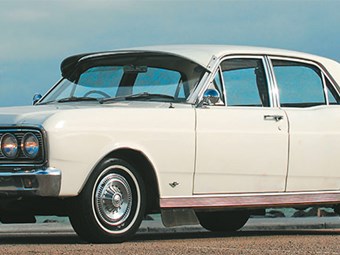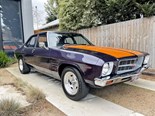Australian Classic Cars Buyers Guide 2013-Pt.1
This could be a good time to secure that dream classic car if you're cashed up, but there be dragons out there

|
|
2013 Australian Buyers Guide
|
2013 Australian Buyers Guide - Classic Cars
> Read Part 2: Market Review here
There is always a ripple of excitement when writing a Value Guide intro at a time of market uncertainty.
After several years of steady values and relatively depressed sales, 2013 has seen more people wandering through the virtual showrooms and lobbing, cash-laden, in the driveways of unsuspecting private vendors.
If a couple of reports typify what’s happening out there, owners of ultra-clean and original 1970s-’90s cars can expect to be approached in carparks and offered attractive sums of money for their cars.
Interest rates at lower notional levels than we’ve seen in 50 years are playing a role, especially as a factor in upward swinging residential property prices. Traditionally, Australians have delved into the big bucket of money under their feet to provide cheap – or so they believe – funding for a ‘hobby’ car.
Hopefully, anyone considering a plunge into collector-car ownership will take notice of the ‘boom and bust’ cycles that have affected this segment of the motor vehicle market for the past 25 years.
Restoring a vehicle which is beyond your own skills, requiring the payment of professionals or failing to confirm identity and authenticity are the most costly errors a specialist vehicle buyer can make.
Buying with borrowed money also needs to be avoided as rising interest rates tend to have the reverse effect on vehicle values.
Genuine cars have traditionally managed to appreciate more quickly and hold their values when tough times return. There is nothing inherently wrong with buying a replica – or ‘tribute’ car as they are now coyly described – but err on the side of caution when negotiating a price. In general and depending on the value of the ‘donor’ car, a replica should not cost more than 60 percent of the price being paid for authentic cars of similar quality.
The ‘muscle’ cars that caused such a furore during the last decade have become ornaments rather than serious recreational transport. Fear of damage or theft will deter many people from getting into the $100,000+ segment of the market however there exist plenty of alternatives.
Cars from the 1980s and ’90s remain generally underpriced. Early ‘Brock’ Commodores are up but the more potent VK Group A and ‘Polariser’ VL are relatively cheap when compared against prices being generated 5-7 years ago.
HSVs with just a couple of exceptions detailed in the Market Review are so cheap that people 10-15 years hence will laugh when you reveal how much a car bought in 2013-14 cost.
The lower end of the market offers some excellent opportunities for wise shoppers. Several varieties of Valiant have doubled in value since 2005 but still cost less than comparable Holdens. XL and 770 Chargers seem stuck in a rut around $30,000 and are worth a look before they find traction.
Scarcity means that older commercial models can fare better than passenger versions. Panel vans in factory-stock condition are frequently worth 50 percent more than sedans, especially when V8 powered. Holden Sandmans now sell more often than not above $25,000 and Chrysler Drifters command $15,000.
How to read Market Reviews
Market Review assessments focus on market movements for various vehicles during the past 12 months and provide, where possible, guidance on realistic pricing for different models available.
The average values shown at the end of each vehicle review are based on surveys of cars offered for sale privately and through licensed dealers in metropolitan markets throughout Australia and on the internet.
Note that the number in brackets following each average price represents the number of vehicles surveyed. Any average based on fewer than 20 vehicles is not necessarily representative of the market position of that particular model at the time.
Where I/D (Insufficient Data) or N/S (None Surveyed) is shown against a model designation, it indicates that no vehicles fitting the description were found during the survey period for this 2013 Buyers Guide.
How to read Price Charts
The values shown in the charts are based on advertised asking prices and reported sales from all parts of Australia, using data supplied by dealers, private purchasers and auction houses. In most cases, the values quoted reflect prices being achieved by vehicles being sold by private vendors.
Where a model is rarely offered on the Australian market, estimates are based on overseas value guides and auction results.
Careful reading of the Condition Category descriptions (see below) is vital to effective use of the Price Charts.
Note: Price tracker boxes indicate price movements of that model since 1998.
> Read Part 2: Market Review here
CONDITION 1
BODY Should be free of dents, rust or obvious repairs. Minor stone chips are permissible, major blemishes or mis-matched paintwork are not. Brightwork must be complete and show no evidence of damage.
INTERIOR Seats should be covered in original-pattern material free of rips or other damage, floor covering complete, clean and of correct material, headlining clean. Dash – especially where timber or veneer is used – should be free of cracks or discolouration.
ENGINE BAY Clean with no water, oil, fuel or battery leaks. Hoses and belts need to be in sound condition. The correct engine or one which was optional to the model should be fitted. Authentic components are a must if the car is to be upgraded to concours standard.
UNDERBODY No dents or damage to underseal, exhaust system complete and undamaged, no oil leaks from the differential, transmission or shock absorbers. All suspension components should be in good working order.
WHEELS & TYRES Original wheels with correct hubcaps or aftermarket wheels in keeping with vehicle style and age should be fitted. Tyres need to be correct size and speed rating, with at least 50 percent original tread.
CONDITION 2
BODY No serious rust or large areas of body filler evident. Minor bubbling in non-structural areas permissible. Paint should be good quality but may show evidence of repairs, chips and scratches. Brightwork should be generally good, although areas of dulled or scratched chrome are likely.
INTERIOR Seats may have been re-covered but should be in good general condition. If the trim is original, areas of wear and broken stitching is likely. Floor coverings should be complete, carpets and hoodlining preferably to original pattern. Cleaning may be required.
ENGINE BAY Engine should be of original type although original engine is unlikely. No major fluid leaks or discolouration. Cleaning will be required.
UNDERBODY No serious damage, however scrapes and chipping likely. Minor oil leaks are common, exhaust should be complete and free from holes or burning around joints. Suspension components such as kingpins, ball joints and shock absorbers need to be roadworthy.
WHEELS & TYRES Wheels should be the original rims or legal-sized aftermarket units. Tyres should have at least legal tread depth left.
CONDITION 3
BODY Moderate rust is inevitable, although chassis, firewall and other structural areas should be sound. Minor body damage is common. Paint likely to be faded, with uneven colour. Body filler usually found in panels but unacceptable in structural areas. Brightwork should be basically complete and major components like the grille must be fitted. Re-chroming or polishing of most parts will be required.
INTERIOR Seats need to be structurally sound but will normally need re-covering. Floor coverings likely to be damaged or missing. Door trims should be fitted but may need replacement. Vinyl dashboard tops usually cracked or warped.
ENGINE BAY The engine should run but work will be needed, with the engine bay likely to be dirty and oil stained. Hoses and fuel lines may need replacement for the vehicle to be reliable.
UNDERBODY Will show signs of neglect and damage (dents, stone damage, etc) but should be free of major rust. Chassis and structural members need to be straight. Suspension components and exhaust systems will usually need replacement.
WHEELS & TYRES Wheels should be free of major damage, but tyres will normally need replacement.
CONCOURS Vehicles in genuine concours condition will be completely original or rebuilt to the highest standards. Generally they are better than when new. Some cleaning or replacement of minor components may be required but anything more than minor blemishes will significantly reduce the car’s chances of success.
Cars with the potential to achieve Gold standard (90 percent or better) in open judging can cost 50 percent or more than Condition One examples.
Disclaimer The author and publisher have made every effort to ensure the accuracy of the 2013 Australian Car Buyers Guide, but we do not accept responsibility for any loss or inconvenience caused by errors or omissions.
Values are subject to change due to social, political or economic circumstances within Australia or elsewhere. Rising fuel prices are a factor that will accelerate depreciation of larger-engined cars and enhance demand for economical models.
To determine the value of a specific vehicle, inspection by an appropriately qualified specialist is strongly recommended.
Unique Cars magazine Value Guides
Sell your car for free right here
Get your monthly fix of news, reviews and stories on the greatest cars and minds in the automotive world.
Subscribe

.jpg)









.jpg)



